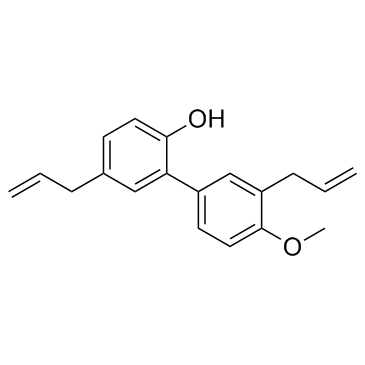4-O-Methyl honokiol (Synonyms: NSC 293101, 4-Methoxyhonokiol) |
| Catalog No.GC35143 |
El 4-O-metil honokiol es un neolignano natural aislado de Magnolia officinalis, actÚa como un agonista de PPARγ e inhibe la actividad de NF-κB, utilizado para la investigaciÓn del cÁncer y la inflamaciÓn.
Products are for research use only. Not for human use. We do not sell to patients.

Cas No.: 68592-15-4
Sample solution is provided at 25 µL, 10mM.
4-O-Methyl honokiol is a natural neolignan isolated from Magnolia officinalis, acts as a PPARγ agonist, and inhibtis NF-κB activity, used for cancer and inflammation research. PPARγ NF-κB
4-O-Methyl honokiol is a natural neolignan isolated from Magnolia officinalis, acts as a PPARγ agonist, and inhibtis NF-κB activity. 4-O-Methyl honokiol (20 μM) increases the expression, transcription and DNA binding activities, and nuclear translocation of PPARγ in both in prostate PC-3 and LNCap cells. 4-O-Methyl honokiol (0-30 μM) inhibits LNCaP and PC-3 cancer cells growth, causes G0/G1 phase arrest and induces apoptotic cell death, and such effects can be reversed by PPARγ antagonist. 4-O-Methyl honokiol inhibits NF-κB activity and cancer cell growth, but such effects as well as its activation of PPARγ can be abolished by knock-down of p21[1]. 4-O-methylhonokiol (0.5, 1 and 2 μM) reduces LPS-induced release of NO, PGE2, ROS, TNF-α and IL-1β in cultured astrocytes, and amyloidogenesis in cultured astrocytes and microglial BV-2 cells[2].
4-O-Methyl honokiol (40 or 80 mg/kg, i.p. everyday for 4 weeks) inhibits the growth of SW620 and PC3 tumours in SW620 and PC3 xenograft model. 4-O-Methyl honokiol significantly increases the expression of p21 and PPARγ in the tumour tissues[1]. 4-O-Methyl honokiol (0.5 or 1 mg/kg/day daily for 3 weeks) significantly ameliorates LPS-induced memory impairment, and inhibits LPS-induced iNOS and COX-2 expression in mice. 4-O-Methyl honokiol also shows inhibitory activities against the Aβ1-42 accumulation, and activates astrocytes and microglia in LPS-injected mice brain[2].
[1]. Lee NJ, et al. 4-O-methylhonokiol, a PPARγ agonist, inhibits prostate tumour growth: p21-mediated suppression of NF-κB activity. Br J Pharmacol. 2013 Mar;168(5):1133-45. [2]. Lee YJ, et al. Inhibitory effect of 4-O-methylhonokiol on lipopolysaccharide-induced neuroinflammation, amyloidogenesis and memory impairment via inhibition of nuclear factor-kappaB in vitro and in vivo models. J Neuroinflammation. 2012 Feb 19;9:35.
Average Rating: 5 (Based on Reviews and 9 reference(s) in Google Scholar.)
GLPBIO products are for RESEARCH USE ONLY. Please make sure your review or question is research based.
Required fields are marked with *




















